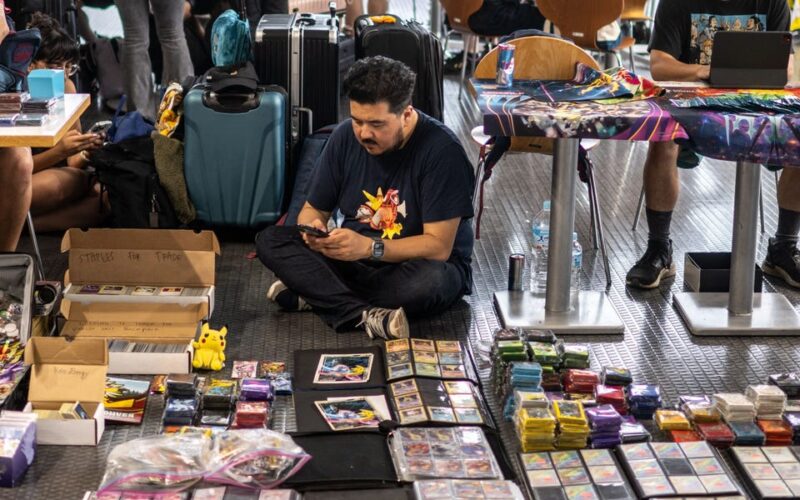The COVID pandemic was an unprecedented boom for the Pokémon card business.
That degree of card fever has waned post-pandemic. But the momentum in renewed interest for Pokémon cards has turned them into the world’s largest collectibles market, at least according to grading company Professional Sports Authenticators.
“It’s basically gone from zero to a third of our volume,” Ryan Hoge, president of PSA, told Business Insider.
Considered the leading authority on the physical condition of millions of collectibles, PSA’s word is the law when collectors assess the quality — and therefore price — of a card.
The company says it receives 75% of all cards sent for grading in the US, and its teams of experts look into every aspect of a card’s appearance, from folds and creases to the luster of its surface.
For much of PSA’s 35-year history, sports memorabilia like baseball and basketball cards were top dog.
But Hoge says Pokémon is now the largest category of cards being graded, fueling a surge in overall demand since the pandemic.
“In 2015, PSA put out a release saying we just graded our 25 millionth collectible. It took us 24 years to do that. In 2023 alone, we graded 14 million,” Hoge said.
He estimated that last year, PSA graded at least 6 million Pokémon trading cards out of the total 14 million it processed.
Launched as a video game series in 1996 for Nintendo’s Gameboy handheld, the Pokémon brand has evolved into a mega-franchise of films, amusement parks, and trading cards that made an estimated $11.6 billion last year.
It’s made a lifetime total of more than 64.8 billion Pokémon cards since 1999, and production has been accelerating rapidly since the pandemic. Over 30 billion of its cards were created after 2019, including 11.9 billion in its 2023 fiscal year ending in March, per updates on its website.
John Keeble/Getty Images)
Hoge said that before the pandemic, most PSA customers sending in Pokémon collectibles would reserve grading only for the rarest, most valuable, and pristine trophy cards.
“But now you’re seeing more people grading, say, the full art cards that you can get out of newer packs, the newer boxes,” Hoge said.
Almost half of the submissions received by PSA this year are from new customers, he added.
Big business for nostalgia-craving millennials
Customers typically spend about 5% of their card’s value on grading, and it costs a minimum of $15 to send in a collectible to PSA.
According to Hoge, PSA caps its prices at a $500,000 card value, so record-breaking cards like the Pikachu that sold for $5.2 million wouldn’t necessarily fetch the company $250,000.
Most customers wait a maximum of two months for their graded card, which returns with a rating between 1 and 10. A higher number indicates better quality, with 10 representing brand-new condition.
That rating usually determines the sale price of a collectible. One mint-condition Pokémon card with a rating of 10 sold for $420,000, even though more than 100 copies of the same card on the market bore the same grading.
IDA MARIE ODGAARD/Ritzau Scanpix/AFP via Getty Images
With prices like these, some buyers see the card trophies as potential for investment, in the same vein as art collecting.
But Hoge said much of the recent burst in Pokémon card collecting stems from younger generations — especially millennials — diving back into their old hobbies.
Decades after Pokémon’s first trading cards were released in the late 1990s, young enthusiasts from that day and age are now adults and have money to spend, Hoge added.
“Nostalgia plays a really key factor,” he said. “When people reach a certain age — typically it’s when they get to their early 30s — and they have some disposable income, they reminisce on their childhoods, and they want to go back to something they enjoyed as a kid.”
Outlasting the ’90s kid generation
Demand growth has been so stark that PSA started a magazine in April covering only trading card games. A few years ago, its main monthly magazine, dedicated to sports memorabilia, may at most have featured one or two articles on Pokémon cards per issue, Hoge said.
Trading card submissions from Japan — for Pokémon and other games related to animes like “One Piece” and “Yu-Gi-Oh!” — have also jumped. PSA, which traditionally stationed its graders and experts in California, has been expanding its Tokyo office of eight people to about 110 staff in the last two years.
John Keeble/Getty Images
Hoge believes the company is seeing the early stages of a Pokémon collectibles industry that’s here to stay beyond millennials. Nintendo has been banking hard on getting today’s generations of children — even toddlers and babies — hooked on its fantasy animal species.
Hoge said that since PSA went private in February 2021, its total staff has surged from 600 to 1900 across California, New Jersey, and Japan.
“I don’t think we’re going to see the kind of insane behavior we saw in 2020 and 2021,” he said. “But I think we’re in a healthy state for the business with a lot of active participants.”
Source link
lol

